I’m reading Clara Hughes’ memoir Open Heart, Open Mind, so this excerpt from Angie Abdou’s novel The Bone Gage about another Olympic contender spoke to me. Abdou also nailed the mood of Calgary during a March chinook, but I hope we won’t see minus twenty again this season. Actually, have we seen it yet this year?
Demon
My reading about modern pschology and psychiatry continued with The Noonday Demon: an Atlas of Depression by Andrew Solomon. I chose this book because a couple of my earlier readings mentioned it, with praise.
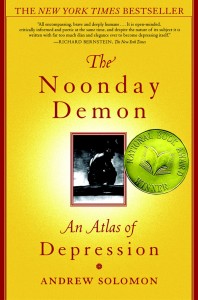
Demon differs from the other five books I’ve read for several reasons. The author, Solomon, is a writer, not a medical expert. While the other books dealt with mental illness, in general, Solomon focusses on depression, from which he has suffered on and off for seven years (as of 2001, the year of the book’s publication). Solomon did extensive research to write the book, as evidenced by the 100 pages of footnotes and bibliography at the end. Demon is part memoir, part medical information, and part life stories of depression sufferers, many of whom contacted Solomon after an article he wrote about his depression was published in the New Yorker in 1998.
Solomon states up front that he disagrees with the current fashion of opposing medication treatment for depession because his father had a lifelong career in the pharmaceutical industry. As a result, Solomon can view the pharmaceuticals as both capitalist and compassionate, with a genuine desire to cure.
Given the vast numbers of antidepressant prescriptions issued today, as in 2001, I don’t know if I’d call an anti-medication view fashionable. Solomon’s pro-meds view comes out through the book when he criticises doctors and patients who favour going off medication once the person feels well, with relapse as a frequent result. 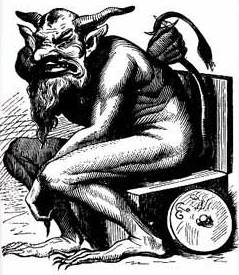
Solomon, himself, suffered his first breakdown when he was 31, following his mother’s death. Already in psychoanalysis, he sought treatment with medication, recovered, broke down a second time, recovered, and suffered a mini-breakdown before completing the book a year later. As a result, his descriptions of his own experience is detailed and fresh. At the time of writing, he was taking about 12 pills a day, some for side effects of his antidepressant and anxiety meds, and expected to continue on a cocktail of medication for life. He accepts the genetic view of mental illness and all his life story cases portray it as a lifelong disease. This would be my main quibble with the book: there is no sense that someone might recover from this demon state until the distant day some major physical treatment is found.
When The Noonday Demon was published, Solomon was 38 years old. He wrote in the book that he was fine with popping pills for life even though he knew they wouldn’t completely do the trick. It beat the alternative of more frequent and severe breakdowns. He’s now 52, and doing well, from my brief Google search. He’s married, with kids, still writes articles and books and is a professor of clinical psychology at Columbia University. (Did he get that post because of his book or a degree?) I’d like to know if he’s still taking multiple medications and still relapsing regularly into depression and, if so, is he still okay with this after sixteen years? I think some of his opinions in Demon might have benefitted from a delayed perspective.
 The Noonday Demon is a big book, large in scope and information. The medical details are as sound as any I’ve read written by practicing psychiatrists and psychologists; Solomon’s opinions as valid as any expert’s, partly because there is no final word on mental illness. Solomon provides many extras the other experts don’t go near. He travelled far and wide to research alternative treatments and try them personally. An exorcism in Africa involved him hugging a ram, the two of them buried under layers of covers, before the ram was sacrificed, its blood drenched over Solomon’s body.
The Noonday Demon is a big book, large in scope and information. The medical details are as sound as any I’ve read written by practicing psychiatrists and psychologists; Solomon’s opinions as valid as any expert’s, partly because there is no final word on mental illness. Solomon provides many extras the other experts don’t go near. He travelled far and wide to research alternative treatments and try them personally. An exorcism in Africa involved him hugging a ram, the two of them buried under layers of covers, before the ram was sacrificed, its blood drenched over Solomon’s body.
Solomon was open enough to find merit in most of these treatments, however unusual, although he didn’t suggest that any could compete with medication, ideally supplemented with psychoanalsis. His view of his fellow sufferers in the case histories is sympathetic. I was surprised, though, that after those hours of hugging, he didn’t show more sympathy toward the poor ram that was sacrificed to exorcise Solomon’s demons.
Heralding Rosalie and Rose
As a regular reader of The Calgary Herald, I was interested this story by author Katherine Govier involving the newspaper.
Curiously, today’s Calgary Herald features author Joan Crate’s new novel Black Apple that bears similarities to Govier’s book. Both deal with First Nations issues and have a protagonist named Rose or Rosalie.
Joan’s book launch is this Tuesday, March 1, at Shelf Life Books. 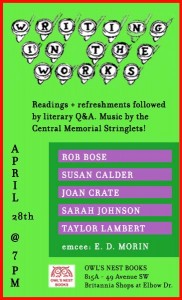 I look forward to reading with Joan on April 28th at Writing in the Works at Owl’s Nest Bookstore.
I look forward to reading with Joan on April 28th at Writing in the Works at Owl’s Nest Bookstore.
Spellbinding
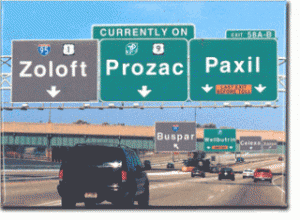 I saved Brain-Disabling Treatments in Psychiatry: Drugs, Electroshock and the Psychopharmaceutical Complex by Peter R. Breggin, MD for the last of my five readings on psychiatry because the book is long – 450 pages – and the title sounded technical. Breggin states at the start that the book is aimed at professionals, although he hopes it’s clear enough for non-professionals to understand.
I saved Brain-Disabling Treatments in Psychiatry: Drugs, Electroshock and the Psychopharmaceutical Complex by Peter R. Breggin, MD for the last of my five readings on psychiatry because the book is long – 450 pages – and the title sounded technical. Breggin states at the start that the book is aimed at professionals, although he hopes it’s clear enough for non-professionals to understand.
Partly for this reason, I only read the first and last sections, along with the brief conclusions he sometimes offered for the middle sections. This was enough to convince me that, of the five books I read, this is the one I have the most affinity with. It also did the most to change my thinking on mental health treatment.
 Breggin, age 79, has been a practicing psychiatrist in upstate New York for over 40 years. He claims he has never prescribed medication and has never lost a person to suicide. He disagrees with the biological model for mental illness and avoids labels such as schizophrenia and biplolar disorder. His approach is to listen to a patient’s life story. That is, to treat him or her as a person and not as a problem to fix.
Breggin, age 79, has been a practicing psychiatrist in upstate New York for over 40 years. He claims he has never prescribed medication and has never lost a person to suicide. He disagrees with the biological model for mental illness and avoids labels such as schizophrenia and biplolar disorder. His approach is to listen to a patient’s life story. That is, to treat him or her as a person and not as a problem to fix.
The part that threw me the most is his belief that psychiatric drugs are not only ineffective, they are harmful and work against recovery by impairing mental and emotional function. People’s belief these medications are helping them are due to the drugs’ spellbinding effect, much like the belief that you are witty and in control when drunk. 
The large middle section of his book is devoted to proving his point for each current treatment, including psychotropic drugs, Electro Convulsive Therapy (ECT or Shock Therapy) and the medications for Attention Deficit Disorder. He especially opposes the current treatment of children for ADD/ADHD and depression. He claims there is an upsurge in diagnoses for bipolar disor today because antidepressants have caused mania in people, who are then told by their psychiatrists that the treatment has unearthed this underlying condition. 
I don’t feel qualified enough to know if his arguments against these treatments are solid or not. This is a second reason I skipped over the book’s middle. A third is that I don’t need his detailed arguments to be convinced, since I favour the nurture, rather than nature, view of mental illness and can easily accept a critique of medication. Breggin states that even if it is one day proven that some disorders are due to chemical imbalances — and there is no proof for this so far — our current drugs and shock therapy aren’t the way to go.
His extreme views made me Google him to find out if he’s a Scientologist, since they are notoriously opposed to modern psychiatry and its treatments. Breggin was associated with the Scientologists in the early 1970s, but wasn’t a member, although his wife was. He broke with the the religion partly because they opposed her marriage to an outsider. No doubt Scientology’s views on psychotropic medication were an attraction for him and the religion might have influenced, or at least reinforced, his thinking. Pharmaceutical companies have accused Breggin of being a Scientiologist to discredit him because he has been an expert witness in lawsuits against their products and vocal in his opposition to them.

Breggin wrote a defense of Tom Cruise’s rants on TV against psychiatry and medication. “The media would have liked to attack Tom on the grounds that he’s a Scientologist,” Breggin says. “Scientologists seem to share a number of views about psychiatry with me, including everything Tom said. In fact, I’d go further. Modern biological psychiatry is a materialistic religion masquerading as a science.”
Breggin’s credentials and clinical experience make it hard to dismiss him as a quack.  I was moved by the final section of his book, where he outlines his 20 tips for an empathetic psychiatry. He notes these guidelines could also be used in our everyday lives with colleagues and friends, and insists they have worked in his psychiatric practice, even with the most difficult and psychotic cases.
I was moved by the final section of his book, where he outlines his 20 tips for an empathetic psychiatry. He notes these guidelines could also be used in our everyday lives with colleagues and friends, and insists they have worked in his psychiatric practice, even with the most difficult and psychotic cases.
Psychosis, he says, is a “loss of connectedness to other human beings. The individual who withdraws into a fearful, self-protective, irrational fantasy responds best to being treated with kindness, respect, and the gradual building of rapport.”
It seems naive, and yet I can see the approach working with one such person I know. I intend to apply it in the future.
Arrival
I got back this week from a four week trip to Mexico and can relate to David Albahari’s experience of a foreigner thrust into Calgary. I’m still a little zoned out.
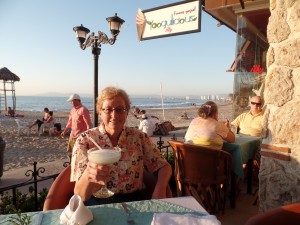
Calgary in February
Continuing the Calgary in winter theme: Weyman Chan.
A New Age of Anxiety?

In the 1950s and 60s, anxiety was the most commonly diagnosed mood disorder in North America. People talked of the Age of Anxiety; The Rolling Stones sang about Mother’s Little Helper, a reference to a tranquilizer commonly prescribed to housewives.
Starting in the 1970s, anxiety became eclipsed by depression. Today, prescriptions for anxiety are dwarfed by antidepressants, the most prescribed medication of our times.
Why this change? ask Allan V. Horwitz and Jerome Wakefield, authors of All We Have to Fear: Psychiatry’s Transformation of Natural Anxieties into Mental Disorders.
And, furthermore, where is the line between natural anxiety and a disorder?
 Their answers to this last question come from an evolutionary perspective. In the primitive world, where dangers were ever-present, anxious vigilence made sense. Fear of strangers, status fears like making a public fool of oneself, fears of snakes, rhodents and heights increased your chances of evading disaster. Better to over-react every time, than to relax once and die. Those anxious genes of survivors were passed on to their modern descendents.
Their answers to this last question come from an evolutionary perspective. In the primitive world, where dangers were ever-present, anxious vigilence made sense. Fear of strangers, status fears like making a public fool of oneself, fears of snakes, rhodents and heights increased your chances of evading disaster. Better to over-react every time, than to relax once and die. Those anxious genes of survivors were passed on to their modern descendents.
In today’s world, strangers rarely present a threat; if one group of friends hate you, you can find another group; city dwellers are unlikely to encounter snakes and in northern climates snakes usually aren’t poisonous. Yet such fears are bred into us and can seriously impact our lives. Fear of flying is a common anxiety because it combines several architypal fears – enclosed spaces, heights, loss of control. It wasn’t clear to me at what point the authors felt these fears should be treated by medicine or therapy, but they got across their view that these anxieties are rooted in human nature. It made me feel less odd about freaking at the sight of a mouse.
The authors’ first question interested me more. Many years ago, I watched a movie — I believe it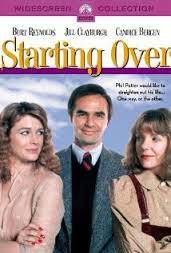 was Starting Over (1979) — where a person had a panic attack at a large gathering of women and a character asked, “Does anyone have a valium?” Every woman reached for her purse. Valium was that decade’s most prescribed anti-anxiety medication, although by 1979 anxiety was already losing ground to depression.
was Starting Over (1979) — where a person had a panic attack at a large gathering of women and a character asked, “Does anyone have a valium?” Every woman reached for her purse. Valium was that decade’s most prescribed anti-anxiety medication, although by 1979 anxiety was already losing ground to depression.
People didn’t change in the 70s and 80s, Horwitz and Wakefield say, becoming less anxious and more depressed. Anxiety and depression have many overlapping symptoms. Sufferers often shift between symptoms of each that could arguably be treated as a single illness. What changed was the diagnosis. This happened for a convergence of reasons.
The anti-psychiatry movement of the 1960s and 70s heightened the psychiatric profession’s inferiority complex (my words) relative other medical specialties. Psychiatrists wanted to be viewed as scientific and, well, medical. They accomplished this by changing the focus of the 1979 DSM (Diagnostic and Statistical Manual) away from unproven causes to symptoms, which could be clearly specified.
 Major depression has always been recognized as a serious illness, one that might require hospitalization, like schizophrenia and bipolar disorder. Around this time, insurance companies were increasinging covering drugs that patients used to pay for on their own. The insurers wanted proof that applicants required treatment for medical reasons. The DSM lll defined depression as a mental disorder, with simple qualifications – two weeks duration and general symptoms that might be mild, moderate or severe. The manual eliminated general anxiety as a disorder, requiring the anxiety be specific (ie. Social Phobia, Fear of Flying) and that it continue for long periods of time, sometimes years. Diagnoses for general malaise quickly shifted to depression so patients could receive insurance payments.
Major depression has always been recognized as a serious illness, one that might require hospitalization, like schizophrenia and bipolar disorder. Around this time, insurance companies were increasinging covering drugs that patients used to pay for on their own. The insurers wanted proof that applicants required treatment for medical reasons. The DSM lll defined depression as a mental disorder, with simple qualifications – two weeks duration and general symptoms that might be mild, moderate or severe. The manual eliminated general anxiety as a disorder, requiring the anxiety be specific (ie. Social Phobia, Fear of Flying) and that it continue for long periods of time, sometimes years. Diagnoses for general malaise quickly shifted to depression so patients could receive insurance payments.
In addition, by the late 1970s, anti-anxiety medications were getting a bad rap, due to claims of their addictive qualities. In the 80s, when the giant pharmaceutical companies developed Prozac and other new types of drugs, they marketed them as antidepressants, although they might as accurately have marketed them for anxiety. In fact, some of those medications have since been approved by the US Food and Drug Administration for specific anxiety disorders. In 1999 the FDA approved Paxil for Social Anxiety Disorder (SAD) and Zoloft for Post Traumatic Stress Disorder (PTSD). Horwitz and Wakefield predict more approvals will follow, breathing new life — and profits — into the tired antidepressants.

They also predict a shift in diagnoses from depression back to anxiety. They note that the same sort of attacks that happened to the anti-anxiety medications in the 1970s are now happening to the antidepressants, “with questions about their effectiveness, side effects, potential addictiveness and safety.” In addition, the patents for the antidepressants will soon start running out, resulting in lower profits for the pharmaceutical companies. This should prompt them to develop newer drugs to treat newly-defined disorders.
The authors add that, “The diagnosis of depression is no longer as useful to psychiatry as it was over the past quarter-century. The profession’s scientific credibility is now far greater than it was in the 1970s, its diagnostic system is generally regarded as reliable, and its biological models are widely accepted.” As a result, they expect psychiatrists to be more willing to diagnose anxiety. It will be treated by the pharmaceuticals’ new type of medication marketed to treat anxiety, now acceptable to insurers as a genuine disorder.
I would add that anxiety is becoming more socially acceptable. It used to seen as a women’s problem; now men are admitting to having it.

Which all means we might be entering a new age of anxiety.
Horwitz and Wakefield present this as a positive, since they favour viewing anxiety as a serious condition, but it left me wondering, do we want to keep letting fads and the pharmaceutical companies call the shots?
Evolution
Psychiatric symptoms are manifestations of ancient adaptive strategies that are no longer appropriate, but can be understood and treated in an evolutionary and development context.
That’s the premise of the book Evolutionary Psychiatry by Anthony Stevens and John Price, published in 1996 & 2000 (2nd edition).
I find that premise not so hard to understand when I relate it to conditions like diabetes and obesity. Back in prehistoric times you couldn’t get too much sugar or store too much fat for the inevitable lean times, so a sugar-addiction or propensity to gain weight increased your chances of survival and opportunities to reproduce and pass your diabetic- and obesity-prone genes to subsequent generations.
 Unfortunately, this natural selection hasn’t caught up with our modern day abundance of sugary and fatty foods. People whose genes are too loaded toward handling scarcity suffer the consequences.
Unfortunately, this natural selection hasn’t caught up with our modern day abundance of sugary and fatty foods. People whose genes are too loaded toward handling scarcity suffer the consequences.
It’s the same with mental illnesses, evolutionary psychiatrists say. Genetic tendencies that let you thrive in the primitive world get distorted under modern conditions. They should be treated as natural, adpative patterns of behaviour that have gone awry.
This seems a more positive approach to mental illness than the old biological and psychological models, although I found that for most of the mental disorders discussed in Evolutionary Psychiatry the authors suggested the natural behaviours go awry due to faulty parenting. Can’t there be other causes?
In the primitive world where danger and scarcity were ever-present, group function was imperative for survival. Stevens and Price claim adaptive patterns were selected to optimize the group’s survival. They divide these patterns into two basic types: those that work toward group cohesion and those that work toward splitting the group when it becomes too large.
In general, traits traditionally defined as neurotic — depression, anxiety, eating disorders, phobias and obsessiveness — were selected to promote group cohesion. Primitive societies were hierarchical and depression, for instance, developed as a response to losing a competition. By withdrawing, rather than fighting back after a defeat, the loser allowed the group to return quickly to equilibrium. As with diabetics, modern depressives are people who inherited too much of that gene and apply it inappropriately or excessively to modern situations.
The book’s discussion of group splitting, or spacing, disorders is particularly interesting. The authors point out how risky it was to split with a primitive group and venture into the wilderness, but someone had to do it, since overly large groups would fall apart socially and put too much pressure on a region’s limited resources. Only someone with a vastly different vision and tendency toward belligerance would make that leap, and so schizoid and paranoid qualities developed. The authors note that history’s charismatic leaders have all been schizoid types, from Joan of Arc to Adolph Hitler to cult leaders like Jim Jones. Presumably, their followers might share those tendencies, without having such strong leader traits.

More often than not, the splinter groups would fail in their harsh new environment, but some would succeed and populate the wilderness with their group-splitting genes. A modern example that comes to mind is Mormon leader Brigham Young, who broke with conventional society and religion, led his people from the eastern USA to Utah and fulfilled his biological goal of producing numerous descendants.
Evolutionary Psychology also muses on the purpose of dreams, which interested Freud too. If there were no purpose to dreaming, the authors say, nature was wasteful in alloting so much of our time to it. They conclude dreams are used to process information, work out problems, and choose what to file in long and short term memory. Dreaming gets us in touch with the archetypes and reconciles us to nature. I’m not quite sure what this last sentence means, but it sounds nice and is something to ponder.
The authors conclude that our treatment of mental disorders must involve confronting the meaning of symptoms. Mental illness should not be viewed as a disaster, like cancer or stroke. It is an ancient adaptive response that requires re-adaption to modern situations. Stevens and Price suggest, for instance, that we don’t necessarily have to change schizophrenics. Studies have shown they are happy in game-play with imaginary followers, becoming virtual Hitlers. This, rather than medication, might be the better treatment.
Timely Story
Suzette Mayr’s novel Monoceros is a Calgary book that I found moving, challenging and memorable.
Top Earning Writer
Who’s the world’s top earning writer? Clue: he leaves the rest of us in the dust. It’s in this month’s issue of Opal Point of View ezine along with tips for social media, blogging for fiction writers and writing accurate crime scene investigation.
Follow this link to view the February issue
http://www.opalpublishing.ca/wp-content/uploads/2016/01/Opal-Point-of-View-February-2016.pdf
You can download a copy of the PDF file from our website www.opalpublishing.ca
|
|
|
|
Copyright © 2016 Opal Publishing, All rights reserved.
Our mailing address is:
McKenzie Towne, Calgary, Alberta
Want to change how you receive these emails?
You can update your preferences or unsubscribe from this list
